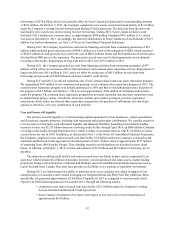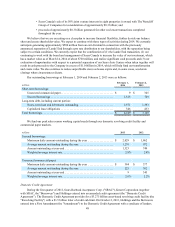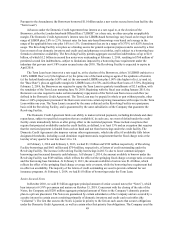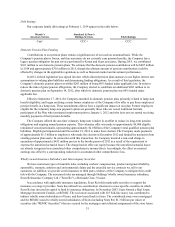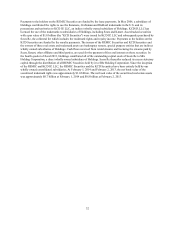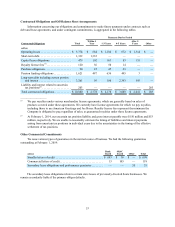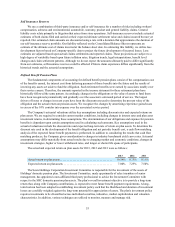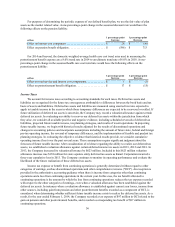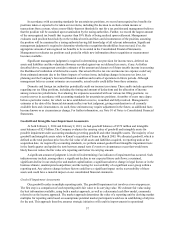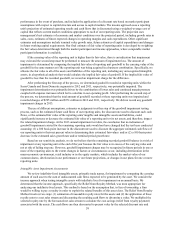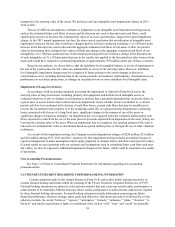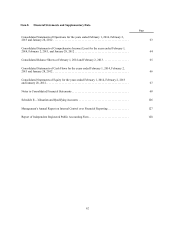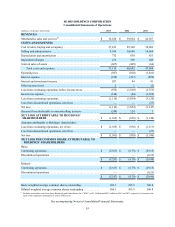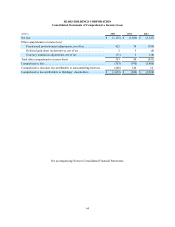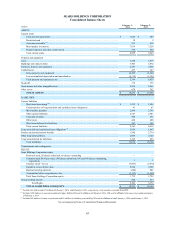Sears 2013 Annual Report Download - page 57
Download and view the complete annual report
Please find page 57 of the 2013 Sears annual report below. You can navigate through the pages in the report by either clicking on the pages listed below, or by using the keyword search tool below to find specific information within the annual report.57
In accordance with accounting standards for uncertain tax positions, we record unrecognized tax benefits for
positions taken or expected to be taken on tax returns, including the decision to exclude certain income or
transactions from a return, when a more-likely-than-not threshold is met for a tax position and management believes
that the position will be sustained upon examination by the taxing authorities. Further, we record the largest amount
of the unrecognized tax benefit that is greater than 50% likely of being realized upon settlement. Management
evaluates each position based solely on the technical merits and facts and circumstances of the position, assuming
the position will be examined by a taxing authority having full knowledge of all relevant information. Significant
management judgment is required to determine whether the recognition threshold has been met and, if so, the
appropriate amount of unrecognized tax benefits to be recorded in the Consolidated Financial Statements.
Management reevaluates tax positions each period in which new information about recognition or measurement
becomes available.
Significant management judgment is required in determining our provision for income taxes, deferred tax
assets and liabilities and the valuation allowance recorded against our net deferred tax assets, if any. As further
described above, management considers estimates of the amount and character of future taxable income in assessing
the likelihood of realization of deferred tax assets. Our actual effective tax rate and income tax expense could vary
from estimated amounts due to the future impacts of various items, including changes in income tax laws, tax
planning and the Company's forecasted financial condition and results of operations in future periods. Although
management believes current estimates are reasonable, actual results could differ from these estimates.
Domestic and foreign tax authorities periodically audit our income tax returns. These audits include questions
regarding our tax filing positions, including the timing and amount of deductions and the allocation of income
among various tax jurisdictions. In evaluating the exposures associated with our various tax filing positions, we
record reserves in accordance with accounting standards for uncertain tax positions. A number of years may elapse
before a particular matter, for which we have established a reserve, is audited and fully resolved. Management's
estimates at the date of the financial statements reflect our best judgment, giving consideration to all currently
available facts and circumstances. As such, these estimates may require adjustment in the future, as additional facts
become known or as circumstances change. For further information, see Note 10 of Notes to Consolidated Financial
Statements.
Goodwill and Intangible Asset Impairment Assessments
At both February 1, 2014 and February 2, 2013, we had goodwill balances of $379 million and intangible
asset balances of $2.9 billion. The Company evaluates the carrying value of goodwill and intangible assets for
possible impairment under accounting standards governing goodwill and other intangible assets. The majority of our
goodwill and intangible assets relate to Kmart's acquisition of Sears in March 2005. We allocated goodwill, which is
defined as the total purchase price less the fair value of all assets and liabilities acquired, to reporting units at the
acquisition date. As required by accounting standards, we perform annual goodwill and intangible impairment tests
in the fourth quarter and update the tests between annual tests if events or circumstances occur that would more
likely than not reduce the fair value of a reporting unit below its carrying amount.
A significant amount of judgment is involved in determining if an indicator of impairment has occurred. Such
indicators may include, among others: a significant decline in our expected future cash flows; a sustained,
significant decline in our stock price and market capitalization; a significant adverse change in legal factors or in the
business climate; unanticipated competition; and the testing for recoverability of a significant asset group within a
reporting unit. Any adverse change in these factors could have a significant impact on the recoverability of these
assets and could have a material impact on our consolidated financial statements.
Goodwill Impairment Assessments
Our goodwill resides in multiple reporting units. The goodwill impairment test involves a two-step process.
The first step is a comparison of each reporting unit's fair value to its carrying value. We estimate fair value using
the best information available, using both a market approach, as well as a discounted cash flow model, commonly
referred to as the income approach. The market approach determines the value of a reporting unit by deriving market
multiples for reporting units based on assumptions potential market participants would use in establishing a bid price
for the unit. This approach therefore assumes strategic initiatives will result in improvements in operational


